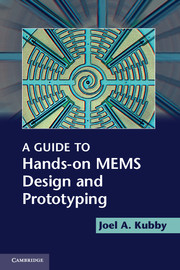4 - Optical MEMS
Published online by Cambridge University Press: 07 September 2011
Summary
Optical MEMS are based on reflection, refraction, diffraction, and interference of light. MEMS technology is well suited for optical applications because light has no mass and so typically only small forces are required for actuation, and light can be passed through an optical window that protects the device from the ambient environment. A number of optical MEMS devices have made it to market including digital projectors, projection TVs, scanners, and displays, both for handheld devices and for head mount displays. Many optical MEMS devices were also developed during the “dot com” bubble, including optical switches, cross-connects, variable optical attenuators, tunable lasers, and tunable filters, although most of these devices never made it to market due to the bursting of the bubble. Some of these development efforts made use of the same multiproject wafer processes in their early prototyping stages and will be examined in detail as case studies here.
Information
- Type
- Chapter
- Information
- A Guide to Hands-on MEMS Design and Prototyping , pp. 74 - 97Publisher: Cambridge University PressPrint publication year: 2011
